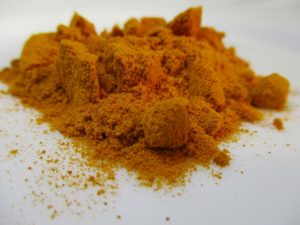
Essential Oils and Herbs for Prescription-Free Pain Relief for Dogs
With old age in both humans and dogs, comes pain. Medication is usually the first place people turn for a solution to pain relief for their dogs, but that can sometimes have negative side effects. For this reason it can be beneficial to use natural remedies that will help relieve your dog’s pain. Essential oils and herbs have been used for centuries to calm stomachs, heal wounds, and ease joint pain – so why not give it to your dog? Essential oils and herbs are natural; therefore you can be confident your dog is getting the best. Here are some essential oils and herbs that offer a prescription-free option for pain relief for your dog:
Turmeric

Turmeric, commonly used in cooking as a spice, is a great prescription-free pain relief for both humans and dogs! Turmeric actually contains a compound called curcumin that acts as an anti-inflammatory to relieve pain from inflammation. As well, turmeric can heal wounds, fight diseases (diabetes, cancer, liver, etc.), and help ward off sickness as an antibacterial. When giving your dog turmeric, it is hard for him to digest and absorb directly so it is recommended that you mix it with another substance (such as coconut oil or with water in his food). The suggested amount for large breeds is about ¾ teaspoon each day. Because your dog ingests it, be sure to observe him afterwards to see if they have any noticeable symptoms to suggest it is not working for him.
Lemon

You have probably heard that lemon is good for us (lemon water, lemon on chicken, etc.), but did you know that it is also good for our dogs? Giving lemon juice to your dog works to reduce allergies, joint pain, cancer, and it acts as a detoxifying agent. Lemon can be a wonderful prescription-free pain reliever for dogs who are older. Older dogs are more likely to suffer from aching joints and lemon works to relieve that pressure. Lemon has an alkalizing effect that helps to balance PH levels in the body. This balance will then reduce the impact of joint pain as well as improve other health-related issues. Give your dog small amounts of lemon daily – such as grating lemon over her food or adding lemon juice to her water. For large dogs, about 2-3 teaspoons a day is the suggested amount. Moderation is key, so start with small amounts and observe your dog’s body and behaviours to ensure she is able to handle it.
Lavender

What many people do not know about lavender is that it has healing properties. Use lavender for times when your dog has irritated skin, infections, wounds, or any other skin abrasions. Lavender acts to soothe the skin as well as heal it, therefore reducing pain associated with the ailment. Lavender is commonly known for its calming effects, and dogs who experience anxiety or stress may benefit from it. When using lavender oil, large dogs can have 3-5 drops topically, but you can dilute it if the scent is too strong for him. Not only will he feel relaxed, but he will smell great too!
Chamomile

Most commonly known as an ingredient found in our relaxing teas, chamomile is a herb that can also provide pain relief for dogs. The tiny little flower is useful when dried out, ground up, and made into a liquid extract. When using chamomile for dogs, it is applied to skin inflammations and acts as an anti-inflammatory. If your dog struggles with stomach problems (gastrointestinal disorders), chamomile can also work to calm these symptoms and relieve pain. When using chamomile to aid stomach issues, it is commonly given in a ground compound taken orally, while skin irritations are topically treated. Over the years, owners have found that chamomile is successful in these areas of discomfort. Depending on how you use chamomile, contact your vet to know how much to give your dog. The concentration can vary depending on the state of substance so it is better to consult a vet prior to use.
Peppermint

Peppermint is one of those wonderful ingredients that benefits both us and our dogs. Whether you use it raw (by the leaf) or as an essential oil, the benefits are numerous. Peppermint is most commonly known for relieving digestive discomfort, and this is true for dogs as well. But what many don’t know is that peppermint can relieve pain too. The essential oil works as an anti-inflammatory and creates a calming and numbing effect. This is beneficial for dogs with joint pain, as the peppermint can reduce the pressure and relieve pain. Your dog can take the peppermint orally or it can also be used on the skin. As a bonus, peppermint also works as an insect repellant when put on your dog’s skin! The recommended dose of peppermint oil for large dogs is about 3-5 drops, unless otherwise mentioned on the label. When using peppermint for the first time, always watch your dog’s behaviour and health. If the essential oil bothers him or isn’t working you should see signs and behaviours (scratching or whining).
Helichrysum

Not a commonly known ingredient, helichrysum is a great option for prescription-free pain relief for dogs. Helichrysum is a yellow medicinal plant that comes from the sunflower family. The plant is made into an essential oil using the top part of the flower and is most commonly used for healing. The essential oil is good for treating dermatitis, reduce bleeding, repair nerves, and act as an anti-bacterial agent. Some even say that it can be beneficial for animals with cardiac disease. This essential oil should only be used on your dog’s skin and not ingested. The recommended amount to use is about 1-4 drops for breeds that are over 50lbs (no dilution necessary).
Frankincense

Frankincense is an oil that has been used for hundreds of years. It is mostly known for its anti-inflammatory properties that make movements easier. Over the years there has been much research on the benefits of this essential oil, and has been found to help in a number of cases. Along with reducing inflammation and making movements easier, it can improve digestion, heal skin, and promote easy breathing. This oil should be used topically for your dog, and is not recommended to be ingested. For older dogs with joint pain, the oil can be gently massaged into points of joint pressure to help movement of these areas. The suggested amount is roughly 1-4 drops, not diluted, for dogs that are over 50lbs.
Remember to always consult your vet about the use of essential oils and herbs as not every dog will react the same way. As well, with most essential oils, always start with less as dogs’ noses are extremely sensitive and the strong smell may bother them. Try these natural essential oils and herbs to relieve the pain your dog experiences. Feel good about giving them something natural that reduces the risk of side-effects that may be the result of prescription drugs.
